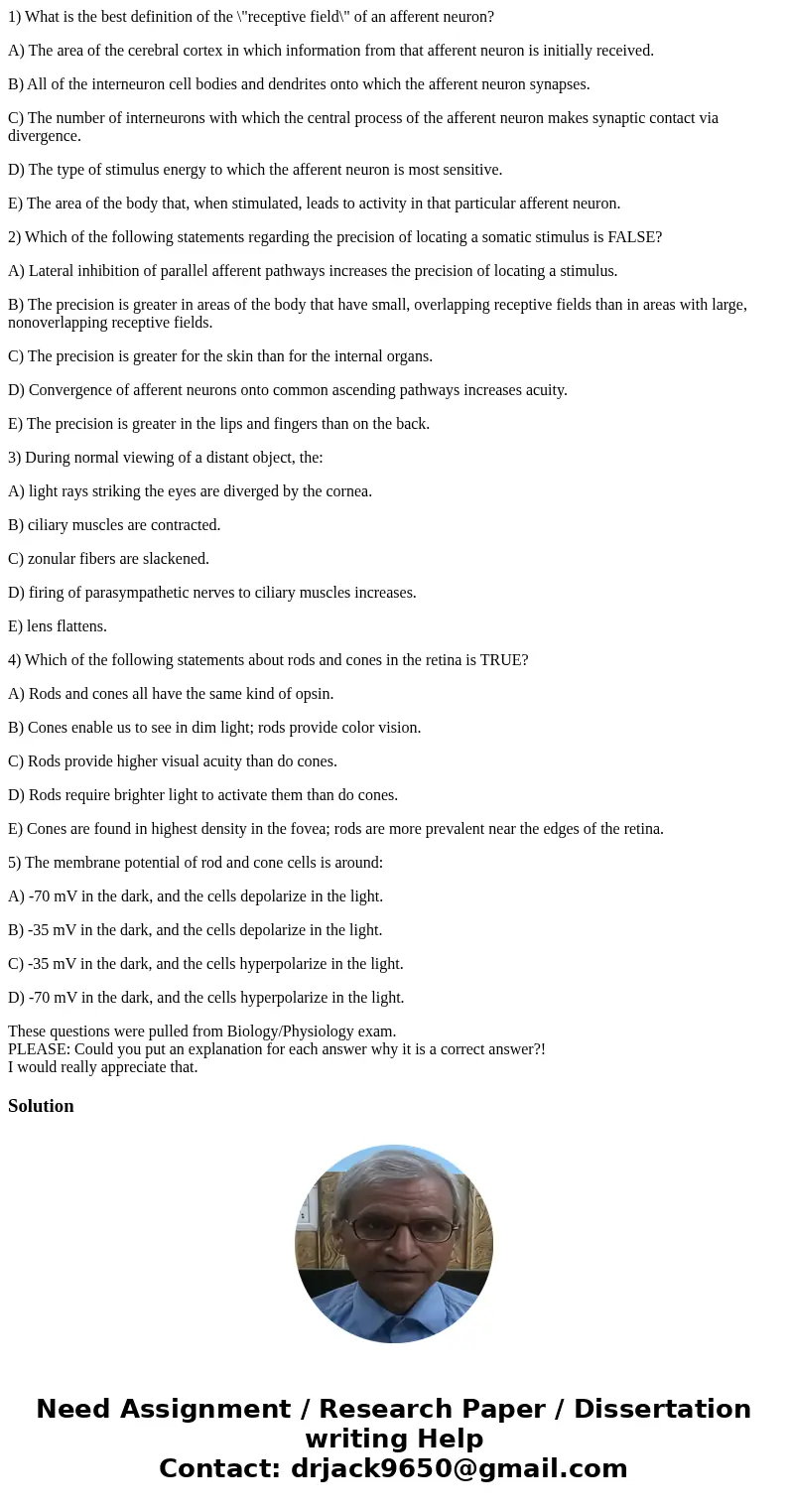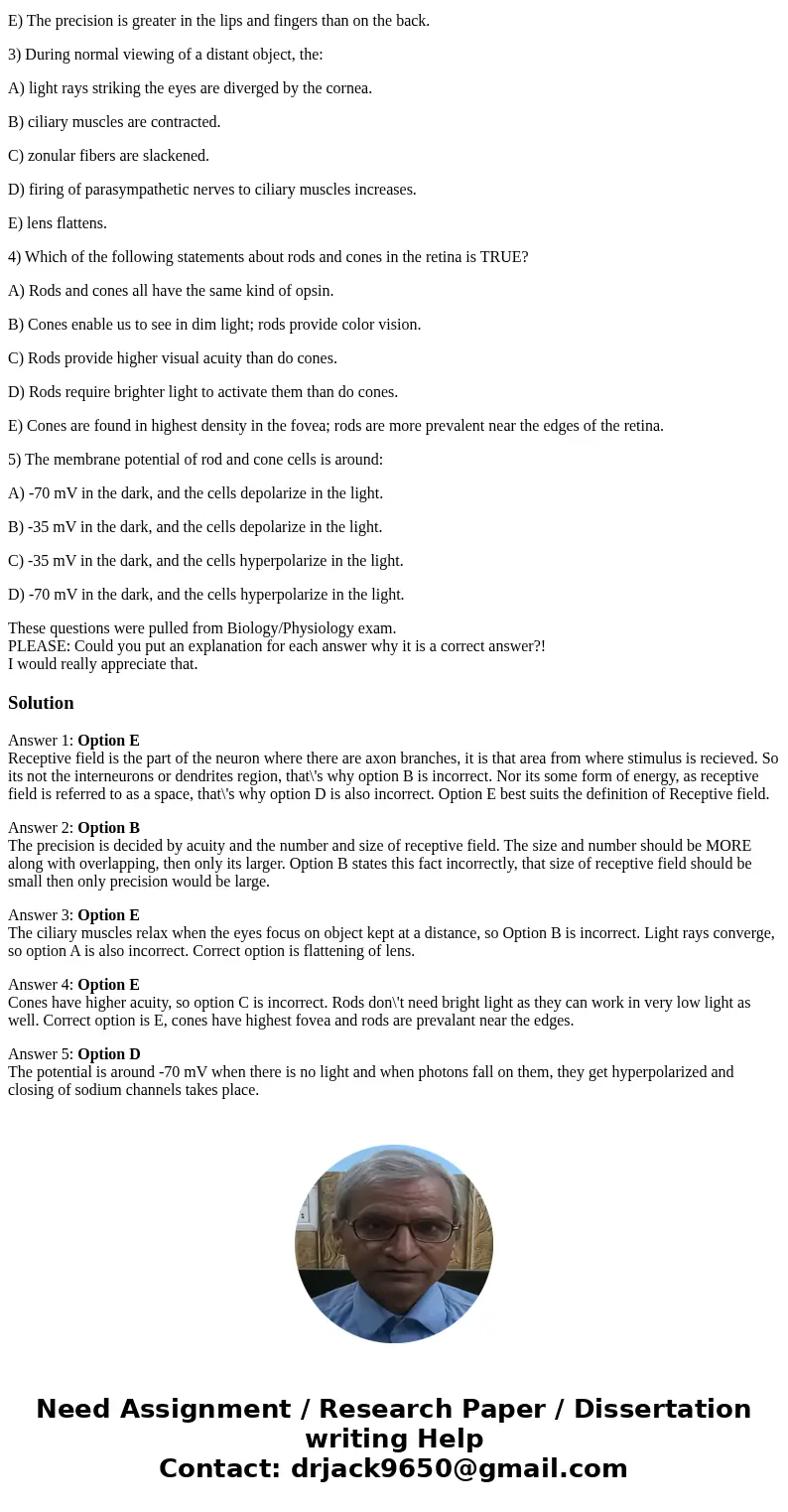1 What is the best definition of the receptive field of an a
1) What is the best definition of the \"receptive field\" of an afferent neuron?
A) The area of the cerebral cortex in which information from that afferent neuron is initially received.
B) All of the interneuron cell bodies and dendrites onto which the afferent neuron synapses.
C) The number of interneurons with which the central process of the afferent neuron makes synaptic contact via divergence.
D) The type of stimulus energy to which the afferent neuron is most sensitive.
E) The area of the body that, when stimulated, leads to activity in that particular afferent neuron.
2) Which of the following statements regarding the precision of locating a somatic stimulus is FALSE?
A) Lateral inhibition of parallel afferent pathways increases the precision of locating a stimulus.
B) The precision is greater in areas of the body that have small, overlapping receptive fields than in areas with large, nonoverlapping receptive fields.
C) The precision is greater for the skin than for the internal organs.
D) Convergence of afferent neurons onto common ascending pathways increases acuity.
E) The precision is greater in the lips and fingers than on the back.
3) During normal viewing of a distant object, the:
A) light rays striking the eyes are diverged by the cornea.
B) ciliary muscles are contracted.
C) zonular fibers are slackened.
D) firing of parasympathetic nerves to ciliary muscles increases.
E) lens flattens.
4) Which of the following statements about rods and cones in the retina is TRUE?
A) Rods and cones all have the same kind of opsin.
B) Cones enable us to see in dim light; rods provide color vision.
C) Rods provide higher visual acuity than do cones.
D) Rods require brighter light to activate them than do cones.
E) Cones are found in highest density in the fovea; rods are more prevalent near the edges of the retina.
5) The membrane potential of rod and cone cells is around:
A) -70 mV in the dark, and the cells depolarize in the light.
B) -35 mV in the dark, and the cells depolarize in the light.
C) -35 mV in the dark, and the cells hyperpolarize in the light.
D) -70 mV in the dark, and the cells hyperpolarize in the light.
These questions were pulled from Biology/Physiology exam.
PLEASE: Could you put an explanation for each answer why it is a correct answer?!
I would really appreciate that.
Solution
Answer 1: Option E
Receptive field is the part of the neuron where there are axon branches, it is that area from where stimulus is recieved. So its not the interneurons or dendrites region, that\'s why option B is incorrect. Nor its some form of energy, as receptive field is referred to as a space, that\'s why option D is also incorrect. Option E best suits the definition of Receptive field.
Answer 2: Option B
The precision is decided by acuity and the number and size of receptive field. The size and number should be MORE along with overlapping, then only its larger. Option B states this fact incorrectly, that size of receptive field should be small then only precision would be large.
Answer 3: Option E
The ciliary muscles relax when the eyes focus on object kept at a distance, so Option B is incorrect. Light rays converge, so option A is also incorrect. Correct option is flattening of lens.
Answer 4: Option E
Cones have higher acuity, so option C is incorrect. Rods don\'t need bright light as they can work in very low light as well. Correct option is E, cones have highest fovea and rods are prevalant near the edges.
Answer 5: Option D
The potential is around -70 mV when there is no light and when photons fall on them, they get hyperpolarized and closing of sodium channels takes place.


 Homework Sourse
Homework Sourse